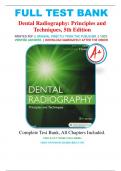FULL TEST BANK
Dental Radiography: Principles and
Techniques, 5th Edition
PRINTED PDF | ORIGINAL DIRECTLY FROM THE PUBLISHER | 100%
VERIFIED ANSWERS | DOWNLOAD IMMEDIATELY AFTER THE ORDER
Complete Test Bank, All Chapters Included.
CHECK OUT MORE FILES HERE:
MEDCONNOISSEURLIBRARIES.COM
,Chapter 01: Radiation History
Iannucci: Dental Radiography, 5th Edition
MULTIPLE CHOICE
1. Radiation is defined as
a. a form of energy carried by waves or
streams of particles.
b. a beam of energy that has the power to
penetrate substances and record image
shadows on a receptor.
c. a high-energy radiation produced by the
collision of a beam of electrons with a
metal target in an x-ray tube.
d. a branch of medicine that deals with the
use of x-rays.
ANS: A
Radiation is a form of energy carried by waves or streams of particles. An x-ray is a beam
of energy that has the power to penetrate substances and record image shadows on a
receptor. X-radiation is a high-energy radiation produced by the collision of a beam of
electrons with a metal target in an x-ray tube. Radiology is a branch of medicine that
deals with the use of x-rays.
DIF: Recall REF: Page 2 OBJ: 1
TOP: CDA, RHS, III.B.2. Describe the characteristics of x-radiation
MSC: NBDHE, 2.0 Obtaining and Interpreting Radiographs | NBDHE, 2.1 Principles of
radiophysics and radiobiology
2. A radiograph is defined as
a. a beam of energy that has the power to
penetrate substances and record image
shadows on a receptor.
b. a picture on film produced by the passage
of x-rays through an object or body.
c. the art and science of making radiographs
by the exposure of an image receptor to x-
rays.
d. a form of energy carried by waves or a
stream of particles.
ANS: B
An x-ray is a beam of energy that has the power to penetrate substances and record image
shadows on a receptor. A radiograph is a picture on film produced by the passage of x-
rays through an object or body. Radiography is the art and science of making dental
images by the exposure of a receptor to x-rays. Radiation is a form of energy carried by
waves or streams of particles.
Wewerethdtyjyufkiligo;p
,DIF: Comprehension REF: Page 2 OBJ: 1
TOP: CDA, RHS, III.B.2. Describe the characteristics of x-radiation
MSC: NBDHE, 2.0 Obtaining and Interpreting Radiographs | NBDHE, 2.1 Principles of
radiophysics and radiobiology
3. Your patient asked you why dental images are important. Which of the
following is the correct response?
a. An oral examination with dental images
limits the practitioner to what is seen
clinically.
b. All dental diseases and conditions produce
clinical signs and symptoms.
c. Dental images are not a necessary
component of comprehensive patient care.
d. Many dental diseases are typically
discovered only through the use of dental
images.
ANS: D
An oral examination without dental images limits the practitioner to what is seen
clinically. Many dental diseases and conditions produce no clinical signs and symptoms.
Dental images are a necessary component of comprehensive patient care. Many dental
diseases are typically discovered only through the use of dental images.
DIF: Application REF: Page 2 OBJ: 2
TOP: CDA, RHS, III.B.2. Describe the characteristics of x-radiation
MSC: NBDHE, 2.0 Obtaining and Interpreting Radiographs | NBDHE, 2.5 General
4. The x-ray was discovered by
a. Heinrich Geissler
b. Wilhelm Roentgen
c. Johann Hittorf
d. William Crookes
ANS: B
Heinrich Geissler built the first vacuum tube in 1838. Wilhelm Roentgen discovered the
x-ray on November 8, 1895. Johann Hittorf observed in 1870 that discharges emitted
from the negative electrode of a vacuum tube traveled in straight lines, produced heat,
and resulted in a greenish fluorescence. William Crookes discovered in the late 1870s that
cathode rays were streams of charged particles.
DIF: Recall REF: Page 2 OBJ: 4
TOP: CDA, RHS, III.B.2. Describe the characteristics of x-radiation
MSC: NBDHE, 2.0 Obtaining and Interpreting Radiographs | NBDHE, 2.5 General
Wewerethdtyjyufkiligo;p
, 5. Who exposed the first dental radiograph in the United States using a live person?
a. Otto Walkoff
b. Wilhelm Roentgen
c. Edmund Kells
d. Weston Price
ANS: C
Otto Walkoff was a German dentist who made the first dental radiograph. Wilhelm
Roentgen was a Bavarian physicist who discovered the x-ray. Edmund Kells exposed the
first dental radiograph in the United States using a live person. Price introduced the
bisecting technique in 1904.
DIF: Recall REF: Page 4 OBJ: 5
TOP: CDA, RHS, III.B.2. Describe the characteristics of x-radiation
MSC: NBDHE, 2.0 Obtaining and Interpreting Radiographs | NBDHE, 2.5 General
6. Current fast radiographic film requires % less exposure time than the
initial exposure times used in 1920.
a. 33
b. 98
c. 73
d. 2
ANS: D
Current fast radiographic film requires 98% less exposure time than the initial exposure
times used in 1920.
DIF: Comprehension REF: Page 5 OBJ: 6
TOP: CDA, RHS, III.B.2. Describe the characteristics of x-radiation
MSC: NBDHE, 2.0 Obtaining and Interpreting Radiographs | NBDHE, 2.5 General
7. Who modified the paralleling technique with the introduction of the long-
cone technique?
a. C. Edmund Kells
b. Franklin W. McCormack
c. F. Gordon Fitzgerald
d. Howard Riley Raper
ANS: C
C. Edmund Kells introduced the paralleling technique in 1896. Franklin W. McCormack
reintroduced the paralleling technique in 1920. F. Gordon Fitzgerald modified the
paralleling technique with the introduction of the long-cone technique. This is the
technique currently used. Howard Riley Raper modified the bisecting technique and
introduced the bite-wing technique in 1925.
DIF: Recall REF: Page 4 OBJ: 7
TOP: CDA, RHS, III.B.2. Describe the characteristics of x-radiation
MSC: NBDHE, 2.0 Obtaining and Interpreting Radiographs | NBDHE, 2.5 General
Wewerethdtyjyufkiligo;p




